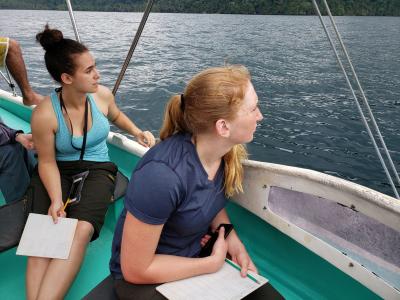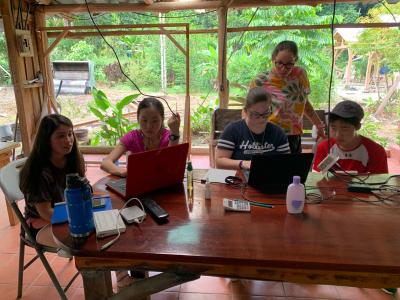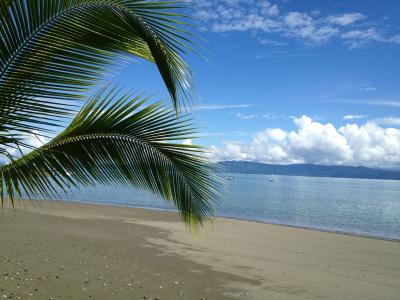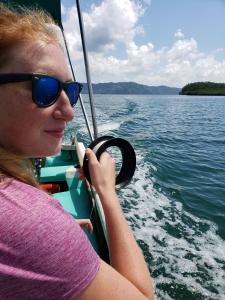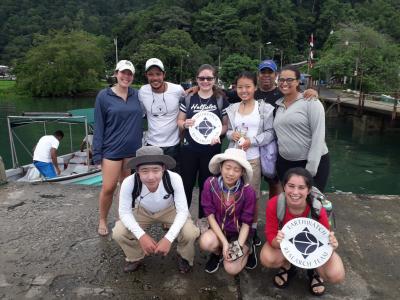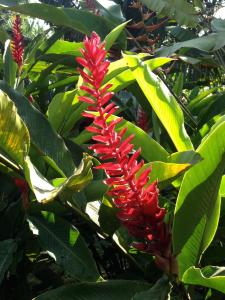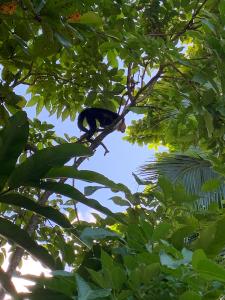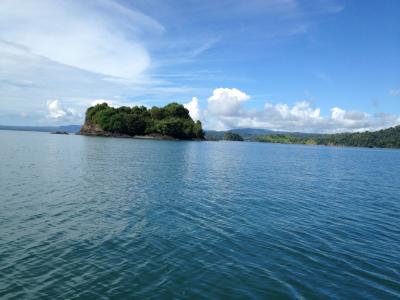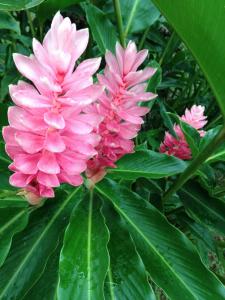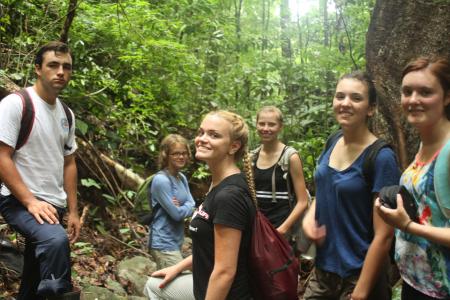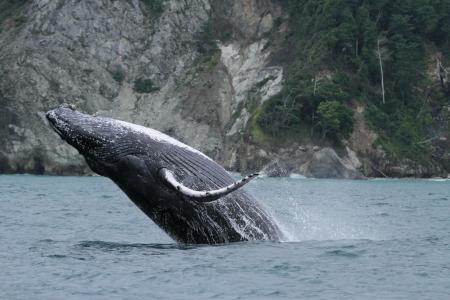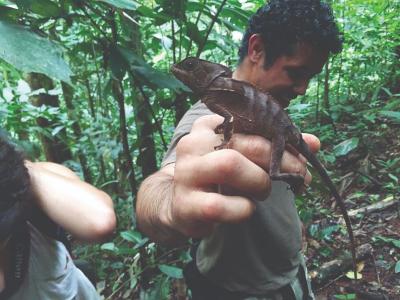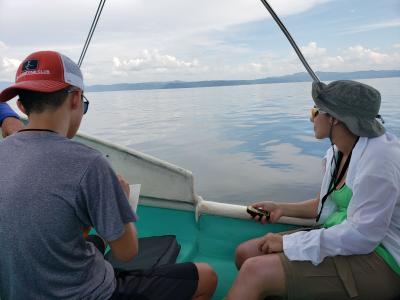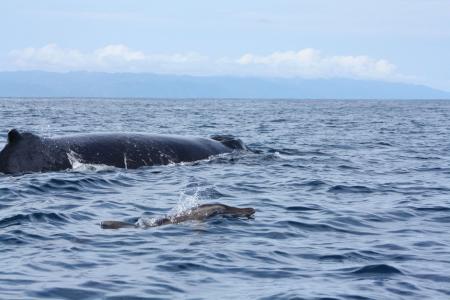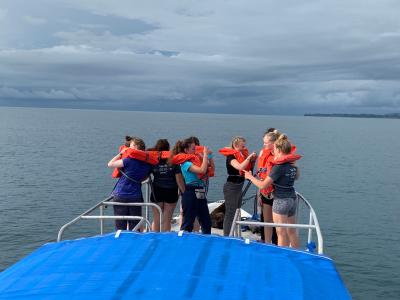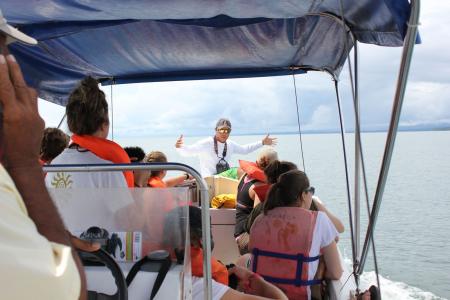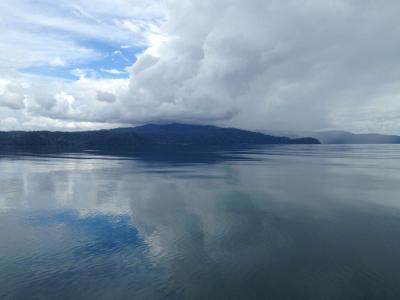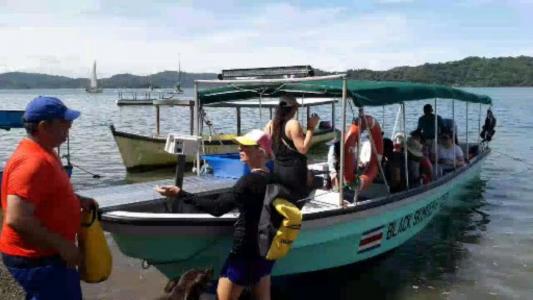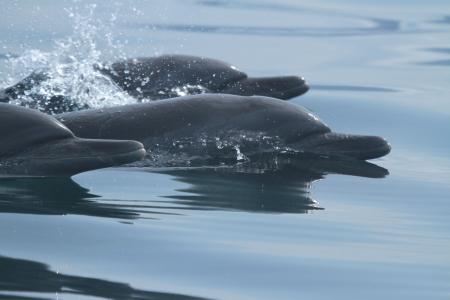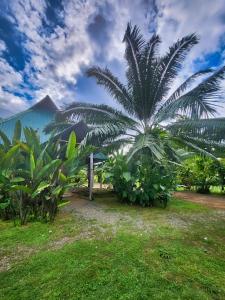.
Please read the following information before leaving for your expedition.
It provides the most accurate information available and will likely answer any questions you have about the project. You may also reach out to your Program Coordinator with any questions you may have.
Click on the images to view full size!
COVID-19 Safety
Please test for COVID-19 before traveling to your expedition; do not travel if you have tested positive, and call Earthwatch right away for the next steps. Visit earthwatch.org/covid-19 for more information on how you can help reduce the risk of COVID-19 impacting your expedition.
The Research
Golfo Dulce, a fiord-like embayment on the southern Pacific coast of Costa Rica, provides an ideal habitat for marine top predators such as cetaceans (whales and dolphins) (Oviedo 2007, Oviedo & Solis 2008, Oviedo et al. 2015, 2018 Pacheco-Polanco et al. 2015). The gulf has long benefited from the large protected terrestrial areas of the Osa Peninsula and adjacent mainland. However, tourism, development, and other human activities are encroaching on this critical habitat and the many species that depend on it.
There is mounting evidence that Marine Protected Areas (MPAs) increase the health and abundance of key marine species and are therefore considered one of the best ways to safeguard the health of coastal ecosystems. But to designate Golfo Dulce as an MPA, scientists first need to understand and demonstrate the importance of this critical ecosystem.
For more than 15 years, scientists have gathered data on species, such as migratory humpback whales, resident bottlenose, and pantropical spotted dolphins, in this marine habitat to evaluate their abundance and distribution. Their findings have led to the establishment of some restrictive measures limiting shipping activities in the Gulf area, but more research is needed to guide future development and management strategies. There is a need for an increased focus on ecological understanding and the preservation of inshore cetaceans since they are exposed to the majority of anthropogenic impacts by sharing the coastal habitat interface.
The preservation of the beauty and well-being of Golfo Dulce’s marine ecosystem benefits everyone—it can help local agencies manage tourism in the area in a sustainable way, which will generate income for the local community and allow tourists to learn about one of Costa Rica’s great treasures without destroying it. The research conducted by Earthwatch teams will help scientists assess this marine habitat's importance and design management plans to protect it.
Marine Life Conservation in Costa Rica
Research Aims
Unlike in the open ocean, the confined nature of Golfo Dulce makes it possible for us to observe whales and dolphins at the surface for extended periods. Through our research, we seek to assess these species’ population sizes and structures, distribution and habitat preferences, socio-behavioral patterns, and how they utilize their gulf habitat. This information will help us develop conservation plans to protect the future marine biodiversity in the gulf. Additionally, with Golfo Dulce being a low-oxygen basin (anoxic) where marine predators thrive, we have the opportunity to understand better the complex dynamic of possible scenarios of climatic change driving the expansion of low oxygen zones in the Pacific Ocean and how upper trophic level organisms would respond under this future potential environmental disruption. In other words, Golfo Dulce is a small-scale model of what will come for tropical marine ecosystems.
Objective 1: Increase the biological information on coastal cetaceans’ critical habitat in Golfo Dulce using behavior sampling and photo-identification. Specifically, this objective seeks to:
- Document changes in habitat use of known areas of critical importance for dolphins, such as foraging areas, breeding and calving habitats, and other areas.
- Document changes in habitat use within key areas for calving and breeding humpback whales.
Objective 2: Deepen the knowledge of the food web in Golfo Dulce to better understand species' ecological role within a trophic web.
Marine Life Conservation in Costa Rica
How You Will Help
The research team will lead you in all research tasks, including observing cetaceans, making photo identifications, recording vocalizations, and collecting data. When you first arrive at camp, you’ll receive an orientation and intensive training on research methods. During the days that follow, you’ll work in small teams or pairs on the following tasks:
- Observing Cetacean Behavior. You will travel on board a 27-foot (nine-meter) motorboat on a few days per team to make observations of whales and dolphins. With a handheld GPS unit, you’ll record the position of cetaceans and any boats spotted (to help us assess how vessel traffic affects cetacean behavior). You’ll also record the size, composition, and behavior of the dolphin and whale groups observed. At the beginning and end of each survey period and every half-hour throughout it, you’ll record environmental data such as water surface temperature and sea condition. In excellent sea conditions, you will also help record cetaceans’ vocal behavior using a hydrophone. Wildlife sightings are extremely likely but not guaranteed. While the chance of seeing dolphins is extremely high, whales are a bit less predictable with respect to the timing of their arrival. The research team focuses on studying the whales from the southern Pacific. Generally, they arrive in early August and depart mid-October to their foraging grounds. Migration patterns vary, and sightings during these months cannot be guaranteed.
- Documenting the Trophic Web in Golfo Dulce. You’ll help record and describe the species in multi-predator assemblages. This includes observing aggregations of schooling fish and predators such as dolphins, seabirds, and sharks. You will collect data on the species composition of the aggregations, the length of the event, and the location.
- Sorting Photos and Identifying Individual Cetaceans. You’ll then help researchers sort photos by species and attempt to match individuals sighted with photos of individuals in an existing photo ID catalog. Photo ID management software is used for the matching process, displaying the encounter history of each individual already identified, along with a high-quality photo of the dorsal fin, which clearly shows natural marks such as notches and nicks. These marks help distinguish between individuals.
Note: All teams will work with dolphins, but only some will work with whales. Whales from the southern Pacific generally arrive in early August and depart in mid-October. These are general patterns and vary from season to season. The team has observed much more variation yearly, and whale sightings are not guaranteed.
Marine Life Conservation in Costa Rica
Life in the Field
DAILY ACTIVITIES
Weather and research needs can lead to changes in the daily schedule. We appreciate your cooperation and understanding.
After breakfast, the team will begin their work for the day. Each day’s tasks will rotate between dolphin and whale surveys, trophic web work, and sorting and cataloging photos for individual identification. For whale and dolphin surveys, the team will usually establish a priority species of the day and focus on finding that species first. The team will change focus to other species throughout the day as time and conditions allow. Photographs for photo-ID and behavior-acoustic sampling are conducted with each focus species.
Lunch is eaten on the boat or in the field. You may help carry light equipment to the boat and load it on. Photo-identification sessions will take approximately two hours, though groups will be on the boat for up to five hours. Everyone on the boat will have a specific task, including handling video and photo equipment, recording instrument readings (such as GPS coordinates), or keeping track of dolphins’ babies—specifically those of identified resident females. Always ask if you need to switch tasks or rest.
Back at camp, the team will check equipment and store audio, footage, and photos collected during the surveys. There will be free time to rest and get out of the sun in the afternoon, followed by data entry and photo ID matching in the evening. The team will eat dinner together, where a discussion on the day’s results and events and the impact on the current research-conservation project is encouraged.
You’re most likely to encounter the target whale and dolphin populations during the following times:
- Spotted Dolphins: Year-round
- Bottlenose Dolphins: Year-round
- Humpback Whales (Southeast Pacific Population): Early August through mid-October; peak presence in August and September
ITINERARY
- Day 1: Arrival; tour of our home base; settling in; orientation and training
- Day 2: Training on dolphin and whale behavior sampling and dolphin photo-identification (including both fieldwork and lab work at camp) and/or possible dolphin survey
- Days 3–7: Boat survey and photo-ID lab work at camp,
- Day 8: Time off to explore or photo-ID lab work at camp
- Day 9: Departure
Marine Life Conservation in Costa Rica
Accommodations and Food
* Please note that not every expedition has couples’ or singles' accommodations available. Please call or email Earthwatch to check availability before reserving your space(s) on the team.
SLEEPING
Volunteers will stay at locally run cabins called El Chontal, situated in the small community of Rincon. Cabins will be shared between two or more volunteers of the same gender. The cabins are rustic and located in the heart of the rainforest. Each is equipped with a fan, though air conditioning is not available. The lodge provides sheets, pillows, blankets, and a bath towel (however, bringing an extra one will be wise). For nighttime protection from insects and other forest wildlife, participants are advised to travel with a mosquito net, which can be hung from a ceiling hook. Pre-treatment of your net with Permethrin or another insecticide offers enhanced protection.
* Earthwatch will honor each person’s assertion of gender identity respectfully and without judgment. For both teen and adult teams, where logistics dictate single-sex accommodations or other facilities, participant placements will be made in accordance with the gender identity the participant specified on their Earthwatch Participant form and/or preferences indicated in discussions with Earthwatch.
BATHROOMS
Bathrooms are shared between 2–3 same-gender volunteers. Hot water showers and flush toilets are available.
There is no bathroom on the boat. The boat is small and does not have an inside cabin. A bucket will be available for bathroom use if someone cannot wait for land. This is standard for small boats and routine for the crew. Everyone aboard will turn away and provide as much privacy as possible.
ELECTRICITY
Electricity is 120 volts, 60 hertz, Type A and Type B plugs (as in the U.S.). You may charge electronic equipment, but please avoid plugging in many appliances simultaneously. It is important to note that power outages occur regularly in Costa Rica’s rainy season (May–November).
PERSONAL COMMUNICATIONS
While Earthwatch and project staff have a communication plan for emergencies, general communications capabilities are very limited at this remote site. Wi-Fi is not available for participant use at the research site.
There may be cell reception in select areas of the El Chontal Ecolodge, though this can be spotty in the rainy season. Please check with your service provider regarding coverage in Costa Rica. If you’d like to make calls during your stay, you should pick up an international prepaid card when you arrive in Costa Rica. The U.S. standard voltage for small appliances, hair dryers, electronic equipment, etc., is 120 volts, 60Hz, supplied through type A or B sockets.
Please note: Earthwatch encourages volunteers to minimize outgoing calls and immerse themselves in the experience; likewise, family and friends should restrict calls to urgent messages only. Emergency communications will be prioritized.
DISTANCE TO THE FIELD SITE
Teams will depart from the Puerto Jimenez pier to conduct research activities on the boat and travel to different areas in Golfo Dulce. The drive from Rincon to Puerto Jimenez is approximately 30 minutes.
FOOD AND WATER
You’ll enjoy typical Costa Rican fare on this expedition, including rice and black beans, meat, vegetables, fruit, coffee, and juice. The team will eat breakfast and dinner together at the accommodations and pack lunches to take into the field daily. The local staff will do all meal prep.
TYPICAL MEALS
The following are examples of foods you may find in the field. Variety depends on availability. We appreciate your flexibility.
- Breakfast: Gallo pinto (rice and beans, the best in the country), plantains, fresh cheese, eggs
- Lunch: Sandwiches, fruit (e.g., watermelon, pineapple, bananas)
- Dinner: Costa Rican-style rice and chicken, salad, pasta with homemade sauce
- Snacks: Each breakfast and dinner will be accompanied by amazing fresh, local fruit juice. The local grocery store is always well stocked with ice cream at our request; the local brand Dos Pinos is very good. You will have the opportunity to buy snacks during the day.
- Beverages: We keep a container of filtered water exclusively for participants. We refill the bottle regularly. We encourage constant hydration and water consumption. You’ll sweat a lot even when not exerting yourself, so it’s a good idea to replenish essential electrolytes by drinking a sports drink (e.g., Gatorade) at least once a day.
SPECIAL DIETARY REQUIREMENTS
Please alert Earthwatch to any special dietary requirements (e.g., diabetes, lactose intolerance, nut, other food allergies, vegetarian, or vegan diets) as soon as possible and note them in the space on your volunteer forms.
This expedition can accommodate most special diets with advance notice. The kitchen staff can provide full options for vegetarians and even vegans. However, some other dietary requirements, such as gluten-free, might be challenging in Golfo Dulce and Osa Peninsula. If volunteers with particular diets bring food complements, staff will gladly assist with special meal preparation.
Marine Life Conservation in Costa Rica
Project Conditions
The following information is as accurate as possible, but please keep in mind that conditions may change.
The camp is on flat terrain, but any hikes (optional) will likely be in hilly areas. The site is about 10 meters above sea level.
The general climate throughout the year is humid and tropical, with a rainy season that extends from May to early November. The dry season runs from mid-November to April, but even during this period, it’s still very humid with regular afternoon showers.
GENERAL CONDITIONS
Please visit Wunderground.com and search for your project location for weather and region-specific information.
Marine Life Conservation in Costa Rica
Essential Eligibility Requirements
All participants must be able to:
- Enjoy being outdoors most of the day in variable weather, in the potential presence of wild animals and insects.
- Tolerate temperatures over 30°C (85°F) and high humidity levels.
- Spend long hours sitting on a boat (some may experience seasickness) for an average of 5 hours per day with only access to a bucket on the boat to relieve yourself for 3–4 days per team.
- Search for dolphin signs (jumps, unusual ripples in the water, movements) on the water's surface while moving aboard the survey boat and on a screen while sitting at a ground station.
- Carry personal daily supplies such as lunch, water, and some small field equipment.
- Climb into and down out of a minibus and ride, seated with the seatbelt fastened, for up to 1.5 hours a day (team dependent).
- Follow verbal and/or visual instructions independently or with the assistance of a companion.
- Take an active role in your safety by recognizing and avoiding hazards if and when they arise (including, but not limited to, those described in Earthwatch materials and safety briefings). Always comply with project staff instructions and recommended safety measures.
- Be able to effectively communicate to the staff if you are experiencing distress or need assistance.
- Be able to get along with a variety of people from different backgrounds and ages, often in close proximity, for the duration of your team.
- Be comfortable surrounded by a language and/or culture different from yours.
Marine Life Conservation in Costa Rica
Health and Safety
EMERGENCIES IN THE FIELD
There is a VHF radio on the boat, mobile phones, two-way radios in some areas, and a landline phone at the cabins. Project staff members are not medical professionals.
Earthwatch has a 24-hour, 7-day-a-week emergency hotline number. Someone is always on call to respond to messages that come into our live answering service.
IMMUNIZATIONS & TRAVEL VACCINATIONS
Please be sure your routine immunizations are up to date (for example, diphtheria, pertussis, tetanus, polio, measles, mumps, rubella, and varicella) and that you have the appropriate vaccinations for your travel destination. Medical decisions are the responsibility of each volunteer and their doctor. Visit the Center for Disease Control and Prevention or the World Health Organization for guidance on immunizations.
If traveling from countries or regions where yellow fever is endemic, you must have a certificate of vaccination.
Staying up to date with your COVID-19 vaccinations, including receiving booster doses, as applicable, is strongly encouraged.
Marine Life Conservation in Costa Rica
Project Risks and Precautions
TRANSPORTATION
Teams may encounter poor road conditions and landslides. Only qualified drivers will transport volunteers in well-maintained project vehicles. Seat belts must be worn at all times. Volunteers are not permitted to drive.
HIKING
Hiking may be offered as an optional recreational activity. You’ll likely traverse uneven terrain and hike uphill in humid tropical conditions; there is a risk of sprains, strains, or breaks due to falling or tripping. You should never walk ahead of the local guide and should follow the guide’s instructions. Wear comfortable, closed-toed shoes when walking. At night, carry a personal headlamp or flashlight.
ANIMALS
- Snakes: Venomous snakes are present in the area. Participants should be vigilant and wear closed-toed shoes for any recreational hikes.
- Insects: You’ll likely encounter many insects; wear long-sleeved shirts and long pants and apply insect repellent frequently to avoid bites. Those with insect allergies should bring the proper emergency treatment and inform staff of the location of the treatment should they need to assist.
- Bats: Bats are prevalent in the Osa Peninsula, including on the premises at El Chontal Ecolodge, and can sometimes enter the cabins. Though human cases are rare, rabies is present in Costa Rica and can be transmitted by bats, amongst other mammals. The pre-exposure vaccination does not eliminate the need for post-exposure medical attention and treatment. Still, it does provide additional protection against the disease in the event of a delay in treatment. The nearest hospital that may offer post-exposure treatment for rabies is in San Jose, though transport to the U.S. may be necessary due to limited availability in Costa Rica. Any animal bites or scratches should be immediately and thoroughly washed with soap, clean water, and a topical povidone-iodine solution or ethanol. If you feel ill once you return from your trip, inform your doctor that you have recently returned from a tropical region.
CLIMATE AND ENVIRONMENTAL HAZARDS
Dehydration, heat exhaustion, sunburn, and other heat-related illnesses can occur, but you can protect yourself by drinking sufficient water, wearing high-SPF sunscreen, and wearing appropriate clothing. Dehydration from sweating can be a problem; please bring water bottles you can easily carry and refill them with electrolyte packets. Because of the high humidity, people who use a hearing aid device may find it doesn’t work properly. Consider purchasing a hearing aid dehumidifier.
The rainy period and hurricane season are generally from May to November. Flooding and landslides may occur during this time and can disrupt road transport. Field staff will monitor local weather and plan activities accordingly. If local authorities or field staff deem it necessary to evacuate the location, follow all instructions.
PROJECT TASKS/EQUIPMENT
Tripping over ropes on the boat or injury from equipment is possible. Upon arrival, you will receive a full safety briefing; please follow all staff instructions. A first aid kit will be available on the boat.
WORKING ON A BOAT
There is a risk of sprains, strains, or breaks from stepping in and out of the boat or during adverse sea conditions. A ladder will be used when entering and exiting the boat. Hazards may result from falling overboard. Some volunteers may get seasick; please bring seasickness medication as a precaution. Boarding and stepping out of an inflatable craft and/or sitting on board when the sea is choppy may cause problems for those with mobility or spinal conditions. These volunteers should carefully consider participation on the project. In addition, volunteers with back, knee, and hip problems, or pregnant women, may face difficulties or discomfort not only when they step on board and leave the boat but also during navigation under choppy sea conditions. Life jackets will be available to each participant and must be worn whenever leaving the inner basin of the gulf and as directed by project staff. Appropriate footwear must always be worn while on deck and the vessel is underway.
PERSONAL SECURITY
Avoid areas designated as off-limits by project staff. Theft and pickpocketing are common crimes in urban centers of Costa Rica, including in tourist areas. If traveling in Costa Rica before or after the expedition, you should take sensible precautions - including avoiding displays of money or valuables and using only official taxis.
SWIMMING
Sharks, rays, sea snakes, crocodiles, and other dangerous wildlife exist in Rincon Bay and adjacent mangrove areas. Swimming is prohibited, including during recreational time and for competent swimmers.
DISTANCE FROM MEDICAL CARE
Arranging transport and reaching the hospital may take an hour or more. If you have a chronic condition that could require immediate medical care (e.g., heart conditions, kidney problems, severe asthma, etc.), or if you are pregnant, please discuss your participation on this expedition with your physician.
COVID-19 DISEASE RISKS
COVID-19 remains an evolving risk to communities and individuals around the world.
Earthwatch strongly encourages you to stay up to date with your vaccinations, including receiving booster doses if available, and to continue to limit your exposure before your program, such as wearing a mask during travel and frequently washing your hands. Persons with a higher risk of severe illness from COVID-19 should consult with their healthcare provider before participation.
If you, or another person on site, display symptoms of illness or test positive for COVID-19, you may be required to wear a mask, test for COVID-19, seek medical advice, isolate/quarantine on- or off-site, cease or limit participation in program activities, and/or take other precautions. If local conditions or recommendations from authorities change, additional requirements may be implemented.
If you must isolate or depart from a program due to COVID-19 or other illness, you will not be entitled to a refund of the contribution for the program, nor any expenses resulting from your participation in the program or a disruption of your travel plans. We strongly encourage you to purchase travel insurance that will cover this eventuality.
DISEASE
Other diseases found in Costa Rica may include rabies, malaria, dengue fever, Zika, tuberculosis, filariasis, leishmaniasis, onchocerciasis, trypanosomiasis, schistosomiasis, strongyloidiasis, hepatitis, leptospirosis, chikungunya, and typhoid. Please see the U.S. Centers for Disease Control and Prevention (cdc.gov) or the World Health Organization (who.int) websites for more information on these conditions and how to avoid them. You can decrease your risk of most diseases by avoiding mosquito bites, practicing good hygiene, and drinking only bottled or filtered water when appropriate. If you feel ill once you return from your trip, please let your doctor know that you have recently returned from a tropical region.
Marine Life Conservation in Costa Rica
Travel Planning
RENDEZVOUS LOCATION
Puerto Jimenez Airport, Puerto Jiménez, Costa Rica
* Earthwatch will provide additional information to meet your team. Please do not book travel arrangements such as flights until you have received further information from Earthwatch.
ABOUT YOUR DESTINATION
Earthwatch strongly recommends that travelers investigate their destination before departure. Familiarity with the destination’s entry/exit requirements, visas, local laws, and customs can ensure smooth travel. The U.S. Department of State's Traveler’s Checklist and Destination Guides are helpful resources. For LGBTI travelers, the U.S. Department of State's LGBTI Travelers page contains many helpful tips and links.
COUNTRY AND PROJECT ENTRY REQUIREMENTS
You are responsible for reviewing and abiding by your destination's entry/exit requirements.
Entry visa requirements differ by country of origin, layover, and destination and can change unexpectedly. For this reason, please confirm your visa requirements at the time of booking and again 90 days before travel. Please apply early for your visa (we recommend starting six months before the start of your expedition). Refunds will not be made for volunteers who cancel due to not obtaining their visa in time to meet the team at the rendezvous. You can find up-to-date visa requirements at the following website: travisa.com.
If a visa is required, participants should apply for a TOURIST visa. Please note that obtaining a visa can take weeks or even months. We strongly recommend using a visa agency to expedite and simplify the process.
Marine Life Conservation in Costa Rica
Resources
ARTICLES
- Oviedo Lenin. 2007. Dolphin sympatric ecology in a tropical fjord: habitat partitioning by bathymetry and topography as a strategy to coexist. Journal of the Marine Biological Association. U.K. 87: 1327–1335.
- Oviedo, Lenin et al. 2008. “The song of the southeast pacific humpback whale (Megaptera novaeangliae) off Las Perlas Archipelago, Panama: preliminary characterization.” Aquatic Mammals. 34: 458-463
- Oviedo, Lenin and Mauricio Solis. 2008. “Underwater topography determines critical breeding habitat for humpback whales near Osa Peninsula, Costa Rica: implications for Marine Protected Areas.” Revista de Biología Tropical. 56(2): 591-602
- Bessesen, B., Oviedo, L., Burdett Hart, L., Herra-Miranda, D., Pacheco-Polanco J.D., Baker, L., Saborío-R, G., Bermúdez-Villapol, L. & A. Acevedo-Gutiérrez. 2014. Lacaziosis-like disease among bottlenose dolphins Tursiops truncatus photographed in Golfo Dulce, Costa Rica. Diseases of Aquatic Organisms. 107(3): 173-180.
- David Herra-Miranda, Oviedo, L., Pacheco-Polanco, J.D. and M. Iñiguez. 2015. Spatial analysis of coastal cetaceans’ critical habitats in Golfo Dulce, Costa Rica: considerations for a marina construction project. IWC/66a/SC/E9. Paper presented at the 66th International Whaling Commission Meeting in San Diego, California, 2015.
- Oviedo, L. Fernandez, Marc., Herra-Miranda, David., Pacheco-Polanco, J.D., Hernandez Camacho, C and D. Aurioles. 2018. Habitat partitioning mediates the coexistence of sympatric dolphins in a tropical fjord-like embayment. Journal of Mammalogy.
- Pelayo-González L., Oviedo L., Márquez-Artavia A., Herra-Miranda D., Pacheco-Polanco J. D., Bessesen B., Guzmán H. M. (2022) Habitat use of south-eastern Pacific humpback whales (Megaptera novaeangliae; Borowski 1781) in Golfo Dulce, Costa Rica. Marine and Freshwater Research. https://doi.org/10.1071/MF21357
BOOKS
- Kricher, John. A Neotropical Companion. 2nd ed. Princeton, N.J.: Princeton University Press, 1999. (The best book on the beauty of the tropical rainforest.)
- Hoyt, Erich. Seasons of the Whale. Moray, Scotland: Colin Baxter, 1998. (The best book on the life of the humpback whale.)
FIELD GUIDES
- Shirihai, Hadoram, and Brett Jarrett. 2006. Whales, Dolphins, and Other Marine Mammals of the World. Princeton, N.J.: Princeton University Press.
- Folkens, Pieter A. 2002. Guide to Marine Mammals of the World. New York: Knopf.
- Garrigues, Richard, and Robert Dean. 2007. The Birds of Costa Rica: A Field Guide. Ithaca, N.Y.: Cornell University Press.
PROJECT-RELATED WEBSITE
- instagram.com/dolphinsgd
- cetaceansgolfodulce.blogspot.com
- facebook.com/CEICdolphins
- http://www.golfodulce.org/biodiversity.html
LITERATURE CITED
- Oviedo, L. (2007). Dolphin sympatric ecology in a tropical fjord: habitat partitioning by bathymetry and topography as a strategy to coexist. Journal of Marine Biological Association of the United Kingdom 87, 1-9.
- Oviedo L. and M. Solis. (2008) Underwater topography determines critical breeding habitat for humpback whales near Osa Peninsula, Costa Rica: implications for Marine Protected Areas. Revista de Biología Tropical 56, 591-602.
- Oviedo, L. Herra-Miranda, D., Pacheco-Polanco, D., Figgener, C. Marquez-Artavia, A., Quirós Pereira, W. and M. Iñiguez. (2015). Diversidad de cetáceos en el paisaje marino-costeros de Golfo Dulce, Península de Osa, Costa Rica. Revista de Biología Tropical, 63 (2), 395-406.
- Oviedo, L. Fernandez, Marc., Herra-Miranda, David., Pacheco-Polanco, J.D., Hernandez Camacho, C and D. Aurioles. 2018. Habitat partitioning mediates the coexistence of sympatric dolphins in a tropical fjord-like embayment. Journal of Mammalogy
Marine Life Conservation in Costa Rica
Sign up for the Earthwatch Newsletter
Be the first to know about new expeditions, stories from the field, and exciting Earthwatch news.
.
.
.


